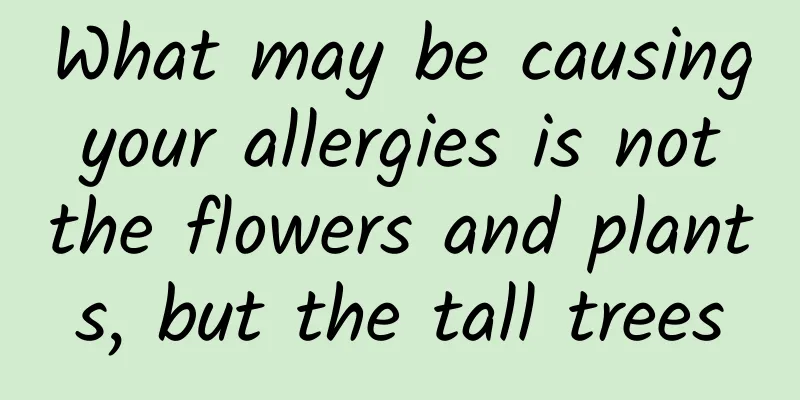What may be causing your allergies is not the flowers and plants, but the tall trees

|
Data show that compared with previous years, the number of allergy patients has increased significantly this spring, and the symptoms of some allergy patients have worsened. Why is this the case? Is it because the immunity of the group has decreased after Yangkang? In fact, it is not an illusion that people are more susceptible to allergies after yangkang, but a real thing. In fact, compared with us, foreign countries that have moved towards passive group immunity earlier have also encountered similar situations of hyperinflammation. Why are people more susceptible to allergies after yangkang? Let's talk about it today. 01. Airway hypersensitivity For example, Gu Qinglong, deputy director of the Children's Hospital affiliated to Capital Institute of Pediatrics, pointed out that the medical explanation is: airway hypersensitivity reaction. Specifically, it refers to the increased reactivity of the airways after being infected by chronic inflammation. For example, COVID-19 infection will cause inflammation, and COVID-19 itself tends to affect the respiratory tract, so the reactivity of our respiratory tract is also increased. Among everyday allergens, most of them cause allergies through breathing. When these allergens reach our airways, and the airways themselves are in a highly sensitive state, allergic reactions are naturally more likely to occur. 02. Mast cell activation syndrome What are the factors behind the COVID-19-induced airway hypersensitivity reaction? Researchers have also tried to find its root cause and found that one of the possible reasons is mast cell activation syndrome (MCAS). In 2020, after the first wave of COVID-19 abroad, researchers noticed that COVID-19 would leave certain effects after recovery, which is what everyone later called long-COVID, and the most typical ones are inflammation and hypersensitivity. The researchers explored many immune phenomena that occur during the COVID-19 pandemic, such as the rapid proliferation and superactivation of T cells, macrophages, and natural killer cells, the excessive production of immune factors and chemical mediators, and noticed an important inflammatory cell: mast cells (MCs) [1]. Mast cells are a type of cell that is widely distributed around microvessels. They can secrete a variety of cytokines and participate in immune regulation. They can also express a large number of Ig receptors and release allergic mediators. During the COVID-19 infection, mast cells participate in virus-related recognition and are activated to synthesize many chemokines and cytokines. For example, mast cells can directly interact with the COVID-19 virus through ACE2. In addition, mast cells are activated by many factors, such as some factors secreted by T cells, damaged epithelial cells (the airways are composed of such cells) and endothelial cells. These mast cells will further recruit immune cells into inflamed tissues. Therefore, a possible relationship between the new coronavirus and mast cells was proposed, that is, mast cells will be over-activated specifically by the new coronavirus, which is different from the normal viral infection that activates mast cells. Researchers investigated the relationship between the incidence of mast cell activation syndrome (MCAS) and the severity of COVID-19 and found that the two appear to be strongly correlated, including in terms of symptoms. For example, the following table describes some of the symptoms of the two. Bold indicates symptoms that coexist in MCAS and COVID-19 [2]. According to some research and evidence, the symptoms of COVID-19, including hypersensitivity after recovery, are most likely related to mast cell activation. Of course, in addition to this reason, after recovery, many people's histamine levels are still higher than normal, so it is natural that when encountering allergens, the symptoms are more obvious. 03. It may not be the flowers and plants that make you allergic, but the tall trees However, spring is the peak season for allergies. Here is a little-known fact: in fact, the main allergens in spring are not the flowers and plants on the ground. The spring equinox has just passed, and most parts of the country have entered spring. It is a good time to go out and enjoy the beautiful spring. What a wonderful thing it is. Confucius would take his disciples to "bathe in the Yi River, enjoy the breeze in the Wu Yu Temple, and sing on their way home" after "the spring clothes were ready". Wang Xizhi would meet with literati and scholars at the Lanting Pavilion in Shanyin, Kuaiji when the spring was warm and the scenery was bright. Just thinking about it makes me feel infinitely beautiful. However, many people dare not go out, because many people are more prone to allergies after the spring, especially in parks and the wild, where there are flowers and plants everywhere. Both doctors and various popular sciences tell us that pollen can easily cause allergies, which makes people stay away from spring. However, there may be a misunderstanding, that is: the flowers and plants on the ground are actually not likely to cause allergies. For pollen allergy, the first key factor must be met: pollen can reach the human respiratory tract. The plants that can easily drift into the human respiratory tract are often wind-pollinated plants, which means that they need to be blown by the wind to spread pollen. This requires that the pollen particles must be small and easy to float in the air so that they can be spread by the wind. Such plants actually have relatively modest characteristics, such as trees such as cypress, sycamore, and birch, or Artemisia plants such as chrysanthemum and dandelion. On the other hand, the flowers and plants we see in our daily lives have such large flowers, but they are rarely pollinated by the wind. They rely more on insect vectors such as bees and butterflies to spread their pollens. In fact, these pollens are not easy to reach our respiratory tract, so they are not easy to cause pollen allergies. Therefore, if you see flowers and plants in the wild, you don’t need to worry too much. Instead, you should be careful about those tall trees, as they may be an important factor in causing infection. 04. Don’t worry if you have allergies, always have medicine on hand Of course, we also need to have a relatively objective understanding of allergies, that is, in general, allergies are a body's response to allergens. When the body encounters allergens, our immune system will respond, such as releasing histamine to increase the permeability of our tissues, making it easier for our immune cells and factors to pass through, thereby quickly eliminating allergens. However, this situation may not be so comfortable in our human body, because the release of histamine can easily cause redness and swelling, and the concentrated immune response can also make us feel uncomfortable, resulting in allergic reactions. In fact, if allergies are not particularly serious, they can generally be solved with allergy drugs, typically antihistamines. This type of drug can reduce the activity of histamine receptors on our nerves and capillaries, which can reduce local vasodilation and reduce allergies. Allergy medicines are now very convenient. Many people go out to play on the weekend, and find that they have allergies when they come back. The hospital is closed on weekends and only has emergency rooms. Or there is nothing going on during the day, and the situation only occurs at night. At this time, it is actually more convenient to buy some emergency medicines. Of course, if the allergy is severe, you can only go to the hospital for treatment. So, is there any way to prevent pollen allergies? Are we helpless? In fact, wearing a mask is a very good way to deal with pollen allergies. In the past three years, many of us have worn masks to get through it. In fact, wearing a mask is a very effective way in the spring when pollen allergies are frequent. After all, pollen particles are much larger than virus particles, and ordinary masks can prevent them. 1. Walker, Margaret E., Julianne K. Hatfield, and Melissa A. Brown. "New insights into the role of mast cells in autoimmunity: evidence for a common mechanism of action?." Biochimica et Biophysica Acta (BBA)-Molecular Basis of Disease 1822, no. 1 (2012): 57-65. 2. Afrin, Lawrence B., Leonard B. Weinstock, and Gerhard J. Molderings. "Covid-19 hyperinflammation and post-Covid-19 illness may be rooted in mast cell activation syndrome." International journal of infectious diseases 100 (2020): 327-332. |
<<: The Noah's Ark of plants has carried 2.4 billion seeds丨Nature Trumpet
>>: How do LCD screens form images? What exactly is liquid crystal?
Recommend
[Popular Science of Chinese Military Technology] As the "King of Rolls" among cruise missiles, what are the outstanding features of the Haiyan nuclear-powered cruise missile?
Recently, according to Russian media reports, the...
Why is the CPU frequency of Xiaomi 5, which costs 1999 yuan, so low?
The three versions of Xiaomi 5 all have the same ...
A collection of 27 early films by Ge You before 2002
Ge You became famous for his comedies and establi...
In the movie "Man Jiang Hong", cherries are rare? In ancient times, this was true.
In the movie "Man Jiang Hong" which was...
How can an enterprise account become a good public account? Teach you 5 tricks
Some time ago, there were many voices criticizing...
Activity review: fission poster activity promotion strategy
Without further ado, let’s get straight to the po...
Are the prescriptions of glasses getting stronger the more you wear them? Don’t ignore these 4 ways to delay the progression of myopia!
Who told you to protect your eyes like this? I wa...
10 UI design trends worth paying attention to in 2020
Editor's note: This article is from UI design...
Xinzheng, is it the “New Zhengzhou”?
Zhengzhou, the capital of Henan Province, has dev...
Frequent dreaming vs. seldom dreaming, who has better sleep quality? The answer is...
People often ask: Oh, I dream too much at night. ...
360 application market promotion mobile display style!
Mobile APP ads are marked with the word "Pro...
Xcode Project Analysis
1. Background Xcode is an IDE for daily iOS progr...
Are canned foods really “junk food”? That may be a little unfair… Eating them this way is healthier →
When it comes to canned food, many people think o...
What are the things to note when submitting promotional materials for 360 advertising, and how long does it take for creative review?
How long does a creative review take? In order to...
How much does it cost to rent a server for a year to develop an app?
APP is a word that has only appeared in our lives...








![[Summer 2021] Senior high school Chinese language decides the college entrance examination Zhang Carter](/upload/images/67cc20194220f.webp)
